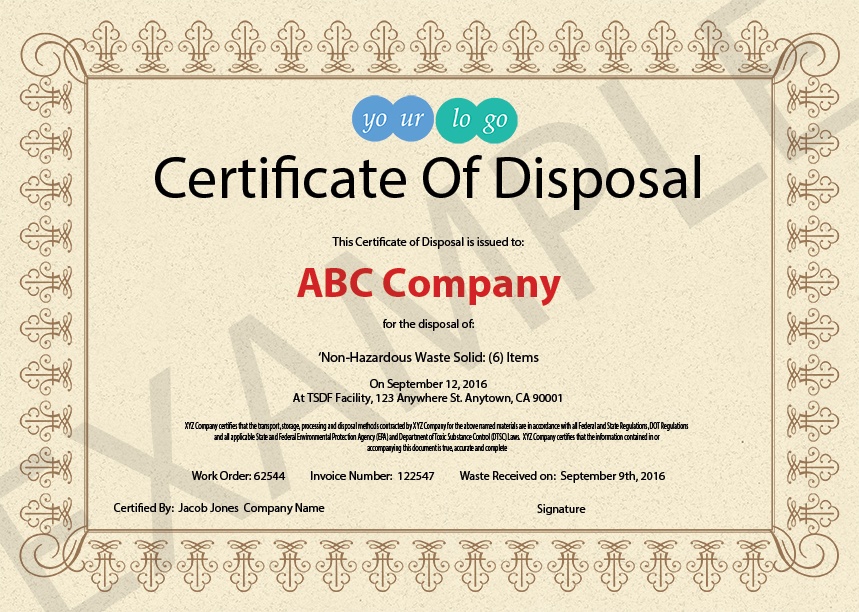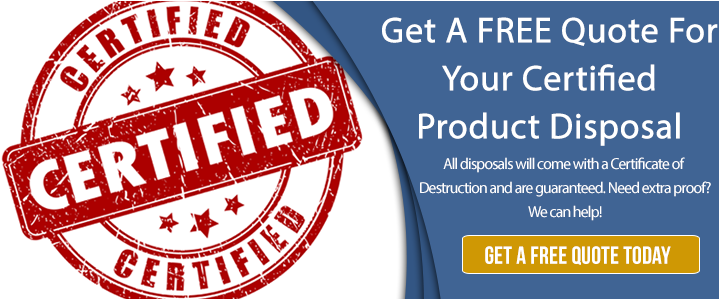When the stakes are high, demonstrating that your business is compliant becomes important when your company’s reputation and future are on the line.
A Certificate of Destruction is a piece of evidence you need to demonstrate that you have taken the disposal of your hazardous waste streams seriously. And those stakes are higher than ever.
Through the Resource and Recovery Act of 1976 (RCRA), hazardous waste generators maintain liability for their waste from “CRADLE TO GRAVE.” This means you are responsible for the waste your company generates even after you have turned it over to a hazardous waste disposal company.
Obtaining a Certificate of Destruction (COD) shows that you have taken the steps necessary to ensure your waste’s final disposal is legal and safe.
Here are the 10 items that should be included on your Certificate of Destruction template every time your waste is transported.
10 Items Every Certificate Of Destruction Needs

One of the most important components of hazardous waste removal is the certificate of destruction. This certificate is just one of the records required when shipping hazardous waste. According to the Department of Toxic Substances (DTSC), a uniform hazardous waste manifest also must accompany most hazardous waste that is shipped off site.
Why are documents like these so important for your company? The certificate of destruction, for example, provides generators with a method of tracking their loads of hazardous waste. This ensures confidence that the waste has been disposed of properly and offers knowledge of where that disposal has occurred.
An experienced hazardous waste transporter will provide a generator with this certificate of destruction (sometimes called certificate of disposal). When you receive one, here are the 10 items every certificate should include and should automatically be a part of the destruction template details:
1. Company/Person Receiving The Certificate
The name of the waste generator goes in this spot. When examining your certificate, make sure the name of your company is displayed as its legal name. This is the first component of establishing a transfer of custody that shows how you turned over materials for destruction.
2. Facility Information
This portion of the certificate includes the name and address of the facility that will accept the waste, store the waste and then destroy the waste.
3. Work Order Number
The work order number is generated when a generator initiates the services of the hazardous waste transportation company. This unique transaction number will allow you to locate your work order and establishes an audit trail if needed.
4. Invoice Number
After the order is accepted and the services are under way, the invoice number can be added to the certificate of destruction. This also establishes an audit trail and is a unique, serialized number.
5. Date The Items Were Received
This date notes when the transporter received the items.
6. Description Of The Waste Received
The accuracy of this section is important because it details exactly what type of hazardous waste is being transported for destruction.
7. Legal Statement
A legal statement from the waste transporter is needed to state all materials are in accordance with regulations. An example of the legal language used in this statement is: “(XYZ Hazardous Waste Transporter) certifies that the transport, storage, processing and certificate of destruction methods contracted by (XYZ Transporter) for the above named materials are in accordance with all federal and state regulations, DOT regulations and all applicable state and federal Environmental Protection Agency (EPA) and Department of Toxic Substance Control (DTSC) laws.”
8. Accuracy Statement
In contrast to the legal statement, the accuracy statement is simple in structure, stating that the information in the certificate of destruction is accurate. An example of an accuracy statement might be: “(XYZ Hazardous Waste Transporter) certifies that the information contained in or accompanying this document is true, accurate and complete.”
9. Signature
The document must be signed and certified by an authorized transport company representative.
10. Certification Date
The certificate also should include the date it was issued to you by the hazardous waste transporter.
An Example of a Certificate of Destruction
When A Certificate Of Destruction Is Needed
A Certificate of Destruction is typically needed in scenarios where sensitive or hazardous materials must be securely disposed of or rendered unusable. Some common situations requiring a Certificate of Destruction include:
- Hazardous Waste Disposal: When disposing of hazardous materials like chemicals, pharmaceuticals or electronic waste, a Certificate of Destruction will ensure compliance with environmental regulations.
- Data Destruction: When paper shredding or disposing of confidential documents, electronic media or sensitive data storage devices, a Certificate of Destruction provides proof that the materials have been securely destroyed to prevent unauthorized access.
- Certified Product Destruction: Companies may need to destroy defective or expired products to prevent them from being resold or misused. A Certificate of Destruction verifies that these items have been properly disposed of, maintaining brand integrity and preventing liability issues.
- Intellectual Property Protection: Destroying prototypes, proprietary information or intellectual property that is no longer needed can safeguard a company’s competitive advantage. A Certificate of Destruction ensures that this information cannot be recovered or exploited by unauthorized parties.
- End-of-Life Equipment: When decommissioning equipment containing sensitive data or hazardous components, such as computers, servers or medical devices, a Certificate of Destruction certifies that these items have been safely and securely disposed of in compliance with relevant regulations.
- Compliance Audits: During regulatory inspections or audits, having a Certificate of Destruction for relevant materials demonstrates proactive adherence to legal requirements and responsible waste management practices.
In other words, a Certificate of Destruction is needed whenever there is a requirement to provide documented evidence that materials or information have been securely and irreversibly disposed of, whether for regulatory compliance, risk mitigation or protection of sensitive assets.
When A Manifest Isn’t Enough
It’s easy to think that a hazardous waste manifest handles the important details. And, while it’s true that information about the load should be indicated on the manifest, there are times when unscrupulous transporters will say one thing to the generator, and actually dispose of the waste somewhere else.
This, in turn, could cause the generator severe legal problems. That’s why requiring a Certificate of Destruction complete with the 10 items listed above is essential for ensuring you have fulfilled all of your legal obligations in the transfer of hazardous waste to a transporter.
Working with experienced, properly licensed and insured hazardous waste transporters that offer a Certificate of Destruction will provide you with the comfort and assurance that the job is being done properly.


Comment